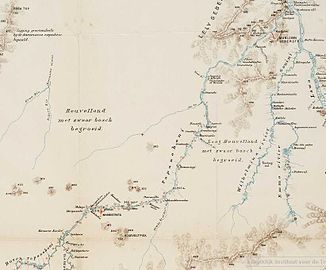Tapanahony (river)
|
Tapanahony Tapanahoni |
||
|
Tapanahony on a map from 1905 |
||
| Data | ||
| location | Suriname | |
| River system | Chestnuts | |
| Drain over | Chestnuts → Atlantic | |
| origin | as Upper Tapanahony in the border and southern Eilerts-de-Haan mountains 2 ° 35 ′ 16 ″ N , 55 ° 58 ′ 19 ″ W |
|
| confluence | at the river island Stoelmanseiland with the Lawa (Aoua) to the Maroni (Marowijne) Coordinates: 4 ° 21 ′ 49 ″ N , 54 ° 26 ′ 7 ″ W, 4 ° 21 ′ 49 ″ N , 54 ° 26 ′ 7 ″ W
|
|
The Tapanahony (also: Tapanahoni) is a river in the southeast of Suriname , in the district of Sipaliwini .
The Tapanahony is a tributary of the Marowijne . It rises in the Grenzgebirge and the southern Eilerts-de-Haan Mountains . Flowing northwards, the upper course of the river breaks through hills and mountains up to a maximum of 700 m high. Here it passes the Tiriyo (also: Trio) villages Alupi 1 and 2. After the Awalapa has been picked up , the Tapanahony flows in a north-easterly direction, along the village of Pelelu Tepu , which has a landing strip. Then it takes up the tributary Blakawatra ( English : black water) and flows past the Tiriyó village of Alopi . Here it unites with the palumeu . Behind the village of Maboga , the direction of the river changes from northeast to east. In this part it has numerous rapids ( called Sula in Suriname ) and waterfalls . After the Tapanahony turns north again, with the Dumansingi and Grinkasaba Falls , it flows at the Granbori Falls into the relatively densely populated Marron area of the Ndyuka with numerous villages. Here the Tapanahony is rich in river islands ( Sranan: Tabiki ) up to the confluence with the Marowijne with Drietabbetje - or Diitabiki as the center and residence of the Ndyuka chief.
The southern area of the Tapanahony has remained unknown for a long time. The Marrons , who had been living freely here since the first peace treaty between the Ndyuka and the Dutch colonial administration in 1760, had refused to collaborate in the exploration of the Tapanahony - and thus their residential areas - well into the 19th century.
literature
- CFA Bruijning and J. Voorhoeve (main editors): Encyclopedie van Suriname . Elsevier , Amsterdam a. Brussel 1977, ISBN 90-10-01842-3 , p. 601.
